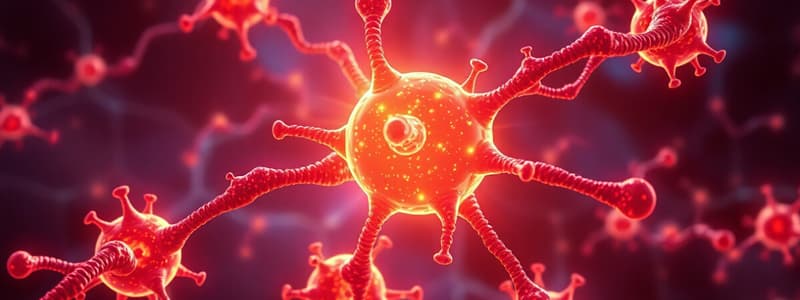Podcast
Questions and Answers
What is the primary reason deaths occur during opioid overdoses?
What is the primary reason deaths occur during opioid overdoses?
- Liver damage leading to internal bleeding.
- Asphyxiation from over-suppression of the respiratory system. (correct)
- Cardiac arrest due to the stimulating effects of opioids.
- Kidney failure due to toxic metabolites.
How does tolerance to opioids in the reward pathway affect the rewarding nature of non-opioid stimuli?
How does tolerance to opioids in the reward pathway affect the rewarding nature of non-opioid stimuli?
- Non-opioid stimuli become equally rewarding as opioid stimuli.
- Non-opioid stimuli become less rewarding as the opioid receptors become less sensitive. (correct)
- Non-opioid stimuli are not affected by opioid tolerance.
- Non-opioid stimuli become more rewarding due to receptor sensitization.
Why is substance use disorder being recontextualized as a disease model?
Why is substance use disorder being recontextualized as a disease model?
- Due to the failure of psychological treatments for addiction.
- Because it primarily affects individuals with pre-existing medical conditions.
- To remove personal responsibility from individuals with addiction.
- To acknowledge the physiological changes in the brain that influence behavior. (correct)
What is the effect of naloxone on opioid receptors?
What is the effect of naloxone on opioid receptors?
Endogenous opioids, such as endorphins, primarily affect pain perception by which mechanism?
Endogenous opioids, such as endorphins, primarily affect pain perception by which mechanism?
Which of the following best describes the primary effect of activating opioid receptors in the context of respiration?
Which of the following best describes the primary effect of activating opioid receptors in the context of respiration?
What is the key distinction between opiates and opioids?
What is the key distinction between opiates and opioids?
Why does increased tolerance to opioids lead to a higher likelihood of overdosing?
Why does increased tolerance to opioids lead to a higher likelihood of overdosing?
What is a key focus of current opioid research?
What is a key focus of current opioid research?
How do opioid drugs effectively manage pain?
How do opioid drugs effectively manage pain?
Which of the following best illustrates the importance of pain perception?
Which of the following best illustrates the importance of pain perception?
How does the brain's reward pathway change in individuals with substance use disorder?
How does the brain's reward pathway change in individuals with substance use disorder?
Why is the suppression of pain perception advantageous in certain survival situations?
Why is the suppression of pain perception advantageous in certain survival situations?
If a patient reports that a prescribed opioid is no longer effectively managing their chronic pain, which of the following is the MOST likely explanation, considering the mechanism of action of opioids?
If a patient reports that a prescribed opioid is no longer effectively managing their chronic pain, which of the following is the MOST likely explanation, considering the mechanism of action of opioids?
A researcher is studying a new drug that binds to opioid receptors but does NOT activate them. How would this drug be classified, and what would its likely effect be on pain perception?
A researcher is studying a new drug that binds to opioid receptors but does NOT activate them. How would this drug be classified, and what would its likely effect be on pain perception?
How does an opioid's mechanism of action differ from that of a local anesthetic like lidocaine?
How does an opioid's mechanism of action differ from that of a local anesthetic like lidocaine?
Why are opioid drugs described as a 'double-edged sword'?
Why are opioid drugs described as a 'double-edged sword'?
What is the primary mechanism behind the development of tolerance to opioid drugs?
What is the primary mechanism behind the development of tolerance to opioid drugs?
How does opioid tolerance affect the experience of pain and pleasure?
How does opioid tolerance affect the experience of pain and pleasure?
What is the role of the ventral tegmental area (VTA) in the reward pathway?
What is the role of the ventral tegmental area (VTA) in the reward pathway?
According to the DA reward experiment, what is the primary role of dopamine in reward processing?
According to the DA reward experiment, what is the primary role of dopamine in reward processing?
Which neurotransmitter system, besides dopamine, is most likely involved in mediating 'liking' or hedonic pleasure?
Which neurotransmitter system, besides dopamine, is most likely involved in mediating 'liking' or hedonic pleasure?
How do endogenous opioids enhance dopamine signaling in the reward pathway?
How do endogenous opioids enhance dopamine signaling in the reward pathway?
How do opioid drugs affect the activity of interneurons in the reward pathway, and what is the consequence of this?
How do opioid drugs affect the activity of interneurons in the reward pathway, and what is the consequence of this?
Why do behaviors prioritize seeking opioid stimuli over non-opioid stimuli after repeated exposure?
Why do behaviors prioritize seeking opioid stimuli over non-opioid stimuli after repeated exposure?
How does the brain adapt to the oversaturation of opioid receptors caused by opioid drugs?
How does the brain adapt to the oversaturation of opioid receptors caused by opioid drugs?
What is a potential long-term consequence of the decrease in opioid receptors due to tolerance?
What is a potential long-term consequence of the decrease in opioid receptors due to tolerance?
Why is there a major drive for relapsing among people with substance use disorder, even after a period of recovery?
Why is there a major drive for relapsing among people with substance use disorder, even after a period of recovery?
During the DA reward experiment, under what conditions were the VTA cells NOT active?
During the DA reward experiment, under what conditions were the VTA cells NOT active?
Which of the following statements best describes how opioid receptors enhance DA signaling?
Which of the following statements best describes how opioid receptors enhance DA signaling?
What is the likely outcome of the neural adaptations in the reward pathway due to chronic opioid use?
What is the likely outcome of the neural adaptations in the reward pathway due to chronic opioid use?
Flashcards
Opioid Receptors
Opioid Receptors
Receptors in the body that bind to opioids, regulating pain, reward, respiration, and more.
Opioids/Opiates
Opioids/Opiates
Naturally occurring substances from opium poppies or synthetic drugs with similar effects.
Endogenous Opioids
Endogenous Opioids
Natural neurotransmitters, like endorphins, that activate opioid receptors.
Endogenous Opioid Pain Suppression
Endogenous Opioid Pain Suppression
Signup and view all the flashcards
Opioids Mechanism
Opioids Mechanism
Signup and view all the flashcards
Pain
Pain
Signup and view all the flashcards
Pain pathways
Pain pathways
Signup and view all the flashcards
Opioids & Pain Management
Opioids & Pain Management
Signup and view all the flashcards
Opioid Tolerance
Opioid Tolerance
Signup and view all the flashcards
Reward Pathway Changes
Reward Pathway Changes
Signup and view all the flashcards
Substance Use Disorder (Opioids)
Substance Use Disorder (Opioids)
Signup and view all the flashcards
Opioids and Respiration
Opioids and Respiration
Signup and view all the flashcards
Opioid Overdose (OD)
Opioid Overdose (OD)
Signup and view all the flashcards
Naloxone (Narcan)
Naloxone (Narcan)
Signup and view all the flashcards
Naloxone's Mechanism
Naloxone's Mechanism
Signup and view all the flashcards
Opioid Research Goals
Opioid Research Goals
Signup and view all the flashcards
Double-Edged Sword (Opioids)
Double-Edged Sword (Opioids)
Signup and view all the flashcards
Endogenous Opioid Function
Endogenous Opioid Function
Signup and view all the flashcards
Acute Effects of Opioids
Acute Effects of Opioids
Signup and view all the flashcards
Homeostasis and Opioids
Homeostasis and Opioids
Signup and view all the flashcards
Effects of Opioid Tolerance
Effects of Opioid Tolerance
Signup and view all the flashcards
Opioids and Reward Pathway
Opioids and Reward Pathway
Signup and view all the flashcards
Reward Pathway Function
Reward Pathway Function
Signup and view all the flashcards
Dopamine's True Role
Dopamine's True Role
Signup and view all the flashcards
DA Reward Experiment Results
DA Reward Experiment Results
Signup and view all the flashcards
'Liking' Signals
'Liking' Signals
Signup and view all the flashcards
Reward Pathway Physiology
Reward Pathway Physiology
Signup and view all the flashcards
Opioids in Reward Pathway
Opioids in Reward Pathway
Signup and view all the flashcards
Opioid-Driven Behavior
Opioid-Driven Behavior
Signup and view all the flashcards
Origin of Dopamine
Origin of Dopamine
Signup and view all the flashcards
Study Notes
Opioid Receptors
- Multiple opioid receptors exist in the body.
- These receptors are usually named after the substance that was discovered to activate them, which is a common practice.
- Opioid Receptors regulate a wide range of processes, including: pain perception, reward-seeking behaviors, hedonic pleasure, and respiration.
- Endogenous opioids, also known as endorphins, activate opioid receptors.
Opioids/Opiates
- Opiates are naturally occurring substances derived from the opium poppy.
- They are active agents in clinically used medications and illegal recreational drugs.
- Opioids is the general term that includes naturally produced opiates from opium poppies and synthetic substances with the same mechanism of action.
- Examples of opioids include: Morphine, Heroin, Fentanyl, Codeine, Oxycodone.
- Opioids are agonists for opioid receptors, meaning they activate the receptor when they bind.
Pain
- Pain is encoded by a subdivision of sensory neurons in the Peripheral Nervous System (PNS).
- Axons carry pain information from the body to the Central Nervous System (CNS).
- Pain is a useful tool for avoiding harmful stimuli, being aware of possible body damage, and learning.
Endogenous Opioid Pain Suppression
- Suppressing pain perception is important for certain survival situations, such as running from danger.
- Some neurons with opioid receptors inhibit the signaling of pain receptors.
- When endogenous opioids activate these receptors, pain sensory neurons are inhibited, temporarily reducing or eliminating pain perception.
Opioids and Pain
- The primary clinical use of opioid drugs is pain management.
- Opioids work by taking advantage of the pain suppression signaling of endogenous opioids.
- Opioid drugs bind to opioid receptors, which effectively and efficiently inhibits pain sensory neurons.
- Opioids block pain signals from reaching the brain, resulting in a lack of pain perception.
Opioids - Pain Management
- Opioids are an important tool to help people mitigate pain due to injury, disease, or medical procedure recovery.
Double-Edged Sword
- Opioid drugs activate all the opioid receptors across the body, and do not act on only pain receptors.
- This leads to other side effects.
Tolerance
- Endogenous opioid receptors in the brain modulate multiple cognitive processes like hedonic pleasure, reward-seeking behavior, and play behaviors.
- Endogenous opioids are released in small quantities.
Opioid Drugs in the Brain
- Opioid drugs interact with all opioid receptors in the brain and body, which influences psychological and physiological processes.
- The concentration of opioid drugs is considerably larger than naturally released endogenous opioids.
Acute Effect of Opioids
- Opioid drugs oversaturate synapses and greatly activate opioid receptors.
- This leads to changes in behavior and perception: analgesia, euphoria, and reward seeking behaviors.
- Short-term behavioral and perceptual changes are typically the desired outcome for opioid users seeking pain suppression or euphoria.
Homeostasis
- Extreme activation of opioid receptors is a deviation from the normal, and the body will want to maintain homeostasis.
- The body will modify neural structures to adapt to abnormal stimuli.
Long-Term Effects of Opioids
- The synapse will want to return to basal activation levels and neurons will detect the over activation of opioid receptors.
- Opioid receptors are removed from the membrane, leading to a weaker response to the same amount of ligand.
Tolerance
- To obtain the same effect, the drug dosage must be increased.
- A higher dose causes over activation of synapse, which results in more synaptic changes.
- The decrease of receptors impacts both opioid drugs and endogenous opioids.
- Opioid receptor mediates behaviors that will be suppressed following tolerance, leading to: increased pain sensitivity, decreased hedonic pleasure, and decreased reward seeking behaviors.
Recovery
- Recovery is unclear if the synapses return to how they were before tolerance.
- Complete recovery could take years, but the major drive for relapsing for people with substance use disorder.
Opioids and the Reward Pathway
- Neural adaptations due to opioid drugs change synaptic communication in the brain's reward pathway.
- Changes in the reward pathway will significantly influence behavior.
Reward Pathway
- The reward pathway is a series of brain areas important for regulating reward seeking behaviors, where Dopamine (DA) is produced in the Ventral Tegmental Area (VTA).
- The Ventral Tegmental Area (VTA) is one of the multiple DA producing regions in the midbrain.
- Axons from the VTA project to the nucellus accumbens (NA) and the cortex.
- The pathway is most active during behaviors associated with motivation and reward seeking behaviors
Dopamine Misconceptions
- Dopamine (DA) is commonly referred to as the "happiness" molecule and is not fully responsible for feeling "happy."
- Drugs that result in experiencing euphoria activate DA neurons.
- Dopamine might be an aspect, but not the major signaling molecule
DA Reward Experiment
- Recording from the DA producing cells of the Ventral Tegmental Area (VTA) in mice and examining activity when a reward is unexpectedly received.
- APs fire when DA is released.
DA Reward Experiment - Results
- Ventral Tegmental Area (VTA) cells are active when receiving an unexpected reward or when a cue associated with reward is presented.
- Ventral Tegmental Area (VTA) cells are not active when receiving an expected reward.
- Dopamine (DA) signaling is not crucial for enjoying a stimuli or is crucial for wanting and reward seeking behavior.
- Dopamine encodes for learning about rewarding stimuli and responding to information associated with a reward.
"Liking" Signaling
- Dopamine does not exclusively mediate "liking" or hedonic pleasure.
- Most likely a complex interaction amongst opioid receptors, endocannabinoid receptors, and Dopamine (DA) receptors.
Reward Pathway Physiology
- The Nucellus Accumbens (NA) has Dopamine (DA) and opioid receptors to mediate reward seeking behaviors.
- Release of endogenous opioids will enhance the activity of DA axons.
- Opioid receptors inhibit an interneuron, reducing its inhibition of the DA axon, and increasing Dopamine (DA) release
Opioids in Reward Pathway
- Activation of opioid receptors will enhance DA signaling, encoding rewarding stimuli.
- Opioids oversaturate opioid receptors on interneurons, greatly inhibiting interneurons.
- DA synaptic signaling is greatly enhanced.
- The Nucellus Accumbens (NA) will encode opioid stimuli as an extremely rewarding experience.
- DA release will be significantly more salient than non-opioid stimuli, motivating repeated exposure to the opioid stimuli.
- Behaviors will prioritize experiencing more opioid stimuli over things like food or social interactions.
Tolerance in the Reward Pathway
- The Nucellus Accumbens (NA) will experience opioid tolerance with high or chronic doses of opioids
- There are fewer opioid receptors on the interneurons, which are less sensitive to opioid drugs and endogenous opioids.
- Leads to increased inhibition on Dopamine Cell (DA).
- Non-opioid stimuli is even less "rewarding"
- Same number of endogenous opioids activating significantly fewer opioid receptors
- Opioid stimuli will be more "rewarding" if opioid doses are increased
- Increased number of opioids to activate the decreased number of opioid receptors
Reward Pathway Changes
- Brain structures responsible for reward seeking are re-wired.
- Behavior changes to prioritize experiencing opioid stimuli over non-opioid stimuli.
- As tolerance increases, drug seeking behaviors increase, creating a positive feedback loop.
Substance Use Disorder
- Addiction is a result of changes in neuroanatomy and behaviors resulting in physical and psychological dependence on opioid drugs.
- Addiction is recontextualized as a disease model, rather than personal choice.
- Neurological changes can occur due to few large dose exposures or chronic exposures.
Naloxone
- Opioid receptors are important for regulating respiration.
- Activation of opioid receptors suppresses breathing and is important for parasympathetic responses.
Opioid ODs
- Deaths due to opioid overdose (OD) are typically due to asphyxiation following over suppression of the respiratory system.
- Increased doses following tolerance increase the likelihood of overdosing.
Naloxone
- Naloxone, commercially known as Narcan, is an opioid receptor antagonist that counteracts the immediate effects of opioids, and can be administered to revert respiratory arrest due to opioid OD.
- Naloxone will block opioid receptors across the whole body, and will not undo the neurological changes that influence behaviors.
Opioid Research
- Opioid Research is a major field to better understand the mechanisms and risk factors for substance use disorder, and the development of non-addictive opioids for clinical use, and recovery from opioid mediated synaptic changes
Studying That Suits You
Use AI to generate personalized quizzes and flashcards to suit your learning preferences.




